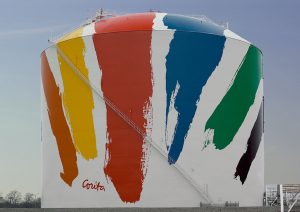On the Southeast Expressway heading into Boston, you’ll come across a famous, or some would say infamous, landmark that’s impossible to ignore. It’s a rainbow-colored municipal gas tank designed by a former Catholic nun named Corita Kent. What makes it infamous is the swatch of blue that many locals swear is a silhouette of Ho Chi Minh. Much like a public Rorschach test, either you see the Communist leader, or you don’t.
I love Corita’s work; she ranks right up there with Warhol, Lichtenstein and all the other pop art masters and in my view, she might be the best of the bunch.
She ripped advertising pages out of magazines, and then blew up the text-laden images and silkscreened them in day-glo colors. Nothing was off-limits as she scrawled handwritten messages invoking peace, love and understanding over riotous graphics that proclaimed an era of change.
For a brief moment, nuns were all the rage in the 1960s. The Singing Nun had a worldwide smash hit, the Flying Nun was on TV every week and Sister Corita made the cover of Newsweek, back when that was a big deal. As her notoriety grew, Corita’s aesthetics put her at odds with the hierarchy of the church, who just didn’t understand the genius of a canvas that portrayed the Holy Eucharist as a Wonder Bread wrapper.
Her outspoken stance against injustice of all kinds, and the Viet Nam war in particular, was the final ecclesiastical straw, and after thirty-two years as a member of the Sisters of the Immaculate Heart of Mary, she left the order, but never gave up her ideals.
I attribute my own artistic awakening to the nuns who taught art class at the parochial high school I attended. Soft-spoken yet self-assured, Sister Lisette managed to pull off the improbable trick of actually looking stylish in the faux prison garb she was required to wear in lieu of a traditional nun’s habit.
In her class we were assigned a weekly sketch, and being heavily into surrealism at the time, I submitted a drawing of an outboard motor about to be sliced in two by a guillotine. In response, she deadpanned that she once knew someone like me and he ended up jumping out of a window. I took it as the highest compliment.
She opened my eyes to the social realism of Ben Shahn, and the raw spirituality of Georges Rouault. Looking back, Sister Lisette did her utmost to turn her classroom into a bohemian salon, taking us twice weekly on a 50-minute trip to the left bank of Paris.
Sister Virginia was equally passionate about art, but gave off a different vibe altogether. She was a Georgia O’ Keefe junkie and shared her addiction to desert landscapes by handing out old Arizona Highways magazines. It almost wasn’t fair. Gazing upon those enchanting images of the American southwest, I was forever hooked.
Aside from providing inspiration, she encouraged me to consider turning whatever talent I had into a career and went so far as to pay a visit to my house to convince my skeptical parents that I should enroll in art school. That didn’t happen, but at least she tried.
Time marches on, and today I don’t know if those two remarkable teachers are still alive or have gone to meet their own personal Jesus. But I’m fully aware of the influence they had on me in my formative years and the lessons they continue to impart every time I pick up a brush.



